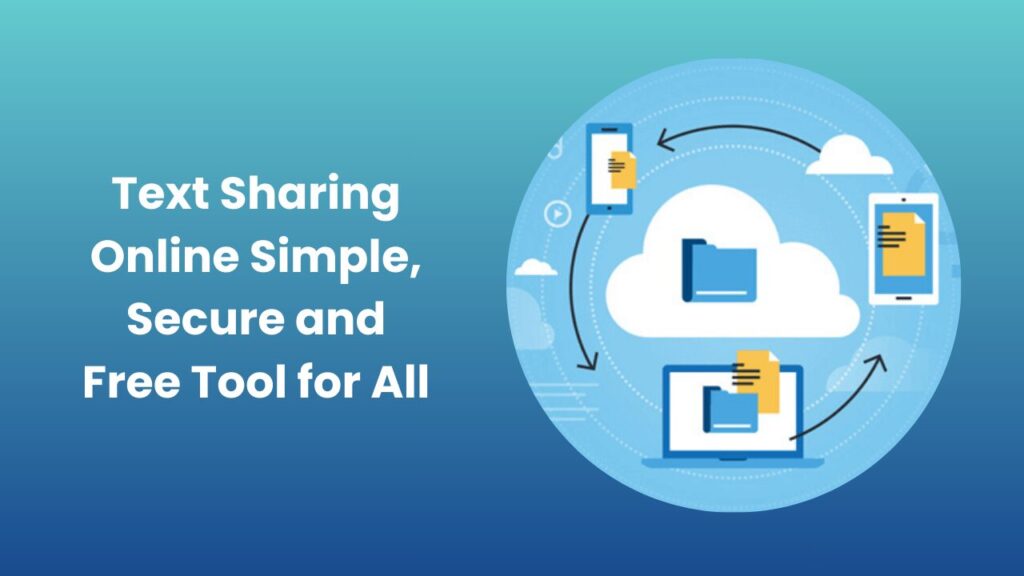The way we communicate has transformed drastically over the last two decades. What once required paper documents, phone calls, or even in-person meetings can now be accomplished in seconds through digital platforms. In particular, sharing information through online tools has become a daily necessity for students, professionals, and casual users alike. Among these methods, text sharing online has emerged as one of the most convenient and effective solutions. By enabling quick transfer of notes, documents, and even code, these platforms simplify communication while ensuring accessibility and security.
The Early Days of Text Sharing
Before advanced platforms existed, people shared text in very limited ways. Emails became one of the first digital tools for text exchange, but they came with restrictions such as file-size limits and formatting inconsistencies. Messaging apps made text transfer faster, yet they lacked the ability to handle large amounts of structured data effectively. This meant that while people could send messages, they often struggled with sharing longer documents, scripts, or formatted content.
As digital collaboration grew, new services emerged to meet the demand for cleaner, faster, and more secure text transfer. Simple paste-and-share websites were the first attempt at solving this issue. Users could copy text into a box, press a button, and instantly generate a link. This eliminated email attachments and provided a streamlined way to send content without friction.
The Rise of Cloud-Based Platforms
The shift toward cloud computing transformed the way text sharing operates. Instead of saving files locally, cloud systems store content on remote servers, allowing users to access it from anywhere with an internet connection. This advancement gave rise to sophisticated text-sharing platforms that combine speed, security, and accessibility.
Cloud-based sharing also introduced version control. Users could not only share text but also update it in real-time, ensuring collaborators always had access to the latest version. This innovation was particularly beneficial for businesses, developers, and educators who needed constant updates to projects, notes, or technical documents.
Why Text Sharing Online Matters Today
The modern digital environment thrives on speed and accuracy. Whether you are working in a professional setting, pursuing academic studies, or engaging in creative writing, the ability to share text instantly saves time and avoids complications. With online platforms, users no longer worry about formatting loss, file incompatibility, or heavy attachments. Instead, they rely on lightweight systems that focus solely on making text available quickly and cleanly.
In addition, these platforms are designed with the global user in mind. Language support, device compatibility, and accessibility features make it possible for anyone to share and view content regardless of their background or technical skills.
How Text Sharing Platforms Work
Most platforms follow a straightforward process. A user copies their text into an input box on the website or uploads a document. The system then generates a unique URL that can be shared across email, chat apps, or social media. Recipients click the link to view the content instantly, with no downloads required.
Some platforms take things further by offering additional features like formatting tools, syntax highlighting for programmers, and comment sections for collaboration. Others allow users to set expiration times so that links automatically deactivate after a certain period. In professional environments, these features prevent outdated or unnecessary documents from remaining accessible.
Behind the Technology
At a deeper level, text-sharing services rely on databases to store content and servers to generate unique identifiers for each shared file. Encryption methods are often applied to secure data in transit, ensuring that only authorized users can view the information. Scalability is also a priority: platforms must handle thousands of simultaneous users without lag or downtime.
The balance between lightweight design and robust infrastructure is what makes these services reliable. Unlike email servers that can get overloaded, text-sharing platforms are built for rapid transfer and instant availability.
Key Features That Define Modern Platforms
Modern platforms are far more than just digital notepads. Their advanced features include security measures such as password-protected links and temporary access. Many also support formatting for technical fields, like syntax highlighting for coding or markdown for structured writing.
Cross-device compatibility is another essential feature. Whether someone opens a link on a mobile device, a desktop computer, or a tablet, the viewing experience remains consistent. This universal accessibility makes online text sharing especially useful in education and remote work environments.
Industry-Specific Applications
Education
Teachers and students rely heavily on online text-sharing platforms. Instructors can distribute reading materials, homework assignments, or study guides with ease, while students can collaborate on group projects or exchange lecture notes. Since many platforms allow real-time updates, they create opportunities for interactive learning outside the classroom.
Information Technology
Developers use text-sharing tools for code snippets, bug reports, and quick debugging sessions. Syntax highlighting ensures that shared code remains readable, while real-time editing supports collaboration on programming projects. For IT teams spread across different locations, this functionality speeds up problem-solving and innovation.
Healthcare
Medical professionals often need to exchange guidelines, patient instructions, or educational material quickly. While sensitive data like patient records require specialized secure systems, text-sharing platforms still play a role in non-confidential communication. Hospitals and training centers use them to streamline internal communication and ensure quick knowledge transfer.
Legal and Corporate Environments
Law firms and corporate organizations handle vast amounts of text-based information, from contracts to policy updates. Sharing these documents efficiently saves time and reduces miscommunication. For sensitive content, security features such as password protection and link expiration are vital to maintaining confidentiality.
Creative Writing and Publishing
Writers, editors, and publishers frequently exchange drafts and manuscripts. Online platforms allow quick review cycles, enabling editors to provide instant feedback. This reduces delays and makes the publishing process more efficient.
Challenges and Limitations
While these platforms provide immense benefits, they are not without challenges. Data security remains the biggest concern. Even with encryption, there is always the risk of unauthorized access if links are shared carelessly. Some free platforms may also have storage limits or lack advanced protections, making them unsuitable for sensitive or long-term use.
Another limitation is internet dependency. Without stable connectivity, users cannot access or share their files. This creates barriers in regions with poor infrastructure or during technical outages. Additionally, there is the risk of over-reliance, where organizations depend too heavily on a single platform, leaving them vulnerable if it experiences downtime.
Security and Privacy Safeguards
To counter these concerns, most reliable platforms employ strong security practices. Encrypted transfers ensure that text remains safe during sharing. Passwords and limited-access links further reduce exposure to unauthorized viewers. Many services also comply with global data-protection standards such as GDPR, reassuring users that their information is handled responsibly.
Some advanced platforms even integrate with enterprise systems, giving organizations control over data storage, access permissions, and content management. These safeguards build trust and allow text sharing to play a role in highly regulated industries.
Choosing the Right Platform
Selecting the best service depends on individual needs. Students may prefer free, easy-to-use platforms, while businesses may prioritize security and collaboration features. Developers often look for syntax support, and writers value simplicity with formatting options. Premium services usually add value with extended storage, advanced encryption, and better customer support.
The decision ultimately rests on balancing cost, convenience, and security. By evaluating your primary use case, you can choose the platform that aligns most closely with your requirements.
The Future of Digital Text Sharing
Innovation continues to push text-sharing services forward. Artificial intelligence is expected to play a major role by offering automated formatting, grammar suggestions, and built-in translation tools. These additions will make sharing not just about distribution but also about enhancing content quality.
Blockchain technology may also influence the field by offering tamper-proof verification of documents. This could be particularly useful in legal and corporate environments where authenticity matters. In addition, biometric authentication like fingerprint or facial recognition could replace traditional password systems, offering both convenience and security.
Integration will be another key trend. Platforms are likely to connect more deeply with productivity suites, project management tools, and communication apps. This will create seamless ecosystems where users can create, share, and collaborate without switching between multiple services.
Conclusion
As the demand for rapid, secure, and effective communication grows, text sharing online has established itself as one of the most practical solutions for individuals and organizations alike. From classrooms to corporate offices, from creative writing to technical development, its applications are broad and impactful. By simplifying collaboration, maintaining data integrity, and evolving with new technologies, these platforms are shaping the future of digital communication. The road ahead promises even greater innovation, ensuring that text sharing remains a vital part of how people connect and exchange ideas in an increasingly digital world.
FAQs
What is it and how does it work?
It is the process of sharing written content through a secure link generated by an online platform. Users paste their text, get a URL, and share it so others can view it instantly without downloads.
Is it secure for sensitive information?
Yes, most platforms use encryption, passwords, and expiration links. For sensitive files, it is best to choose a trusted service and enable extra security settings.
Who uses online text-sharing platforms the most?
Students, teachers, professionals, developers, and writers all use these platforms. Even casual users rely on them for notes, recipes, and personal content.
Can I share large text documents through these platforms?
Yes, many services allow long documents with proper formatting. Free versions may have limits, but premium plans support larger and more complex files.
What are the main advantages?
It saves time, avoids formatting issues, and works on any device. Added features like password protection, link expiry, and collaboration tools increase convenience..
What does the future of online text sharing look like?
Future platforms will likely add AI formatting, real-time translation, blockchain verification, and biometric logins to improve both security and ease of use.





